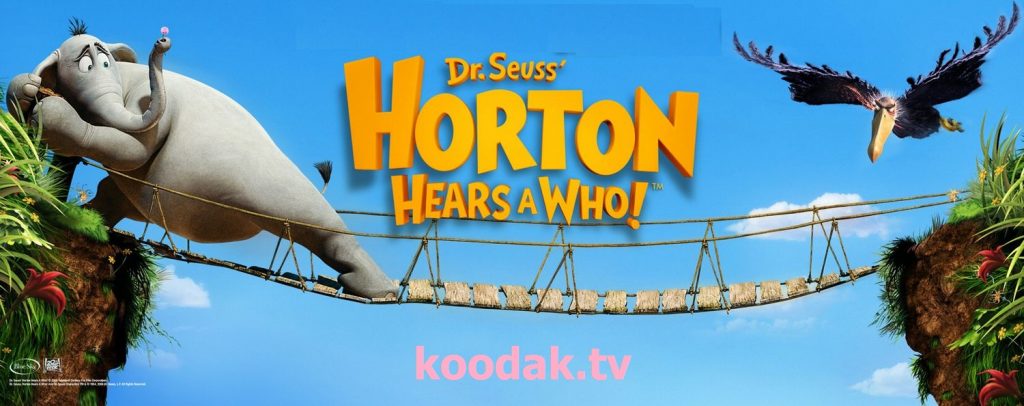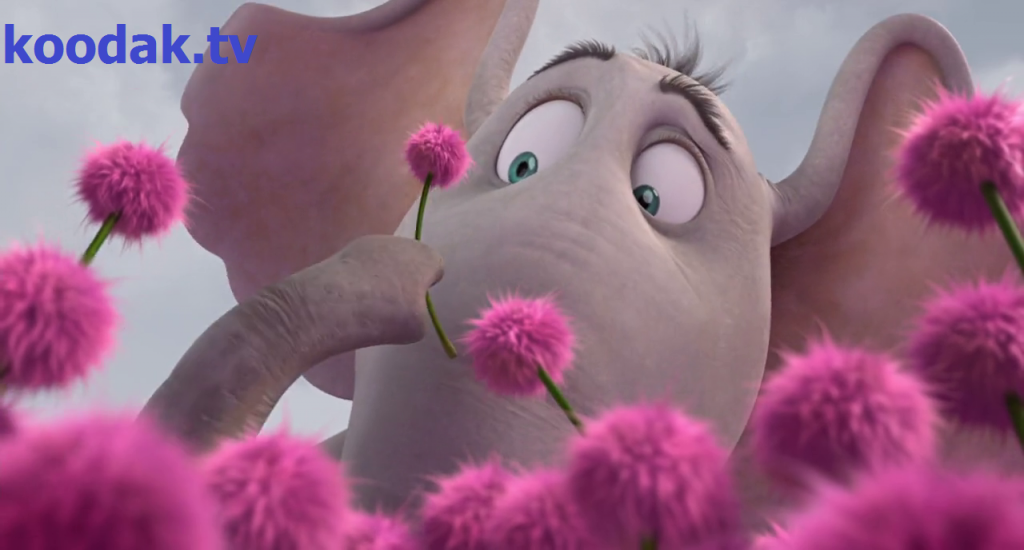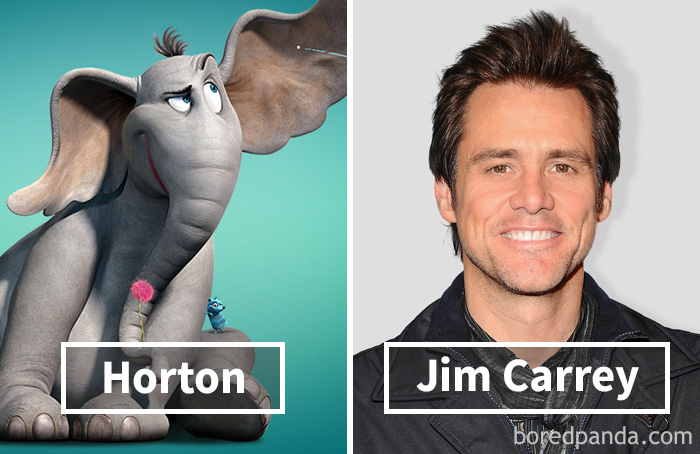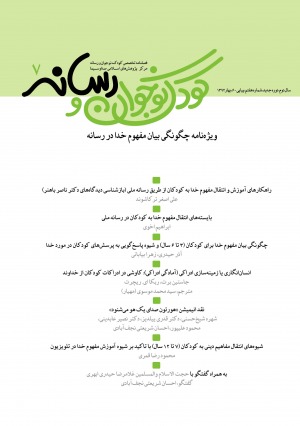Introduction
This animated flm, distributed under the name of Horton in Iran, is a production of the Blue Sky Studios in 2008. The present review is written based on the English version of the movie with respect to many changes made in its Persian dubbed version. The main story of the movie is based on a children’s book of the same name and it adheres to the original book very well. This movie co-directed by Steve Martino and Jimmy Hayward in Blue Sky Animation Studios in 2008 and featured the voices of Jim Carrey, Steve Carrel, Carroll Burnett, Will Arnett and Seth Rogen, was liked by many people at the time of playing. At the time of the screening, there was a lot of debate about the faith in God among the audience, which can still be accessed on the Internet.
The story
The film’s main story is about an elephant that realizes, in a coincidence, some creatures live on a speck of dust. Because of this understanding, his jungle neighbors put him in trouble, but by the end of the film, everyone realizes he was right.
In addition to believing in the supernatural subjects, the general story of this animation deals with many other topics such as the rejection of democracy, being moody, the community authorities abusing of people’s trust, the difficulties faithful people face in a faithless society, sacrifice, perseverance and kindness. Given that this story has focused on an important and unprecedented subject, faith, the film should be critiqued and evaluated in a group of people from various fields of expertise; therefore, it has been analyzed here regarding its creators’ beliefs on some important and invisible issues such as God, angel, heaven, and hell. The movie reviewers don’t believe in these issues, but we have a different view-point about the film based on Islam’s teachings. In the new doctrines of Christianity, faith has been significantly contrasted with the rationalist approach; but given that we are at the beginning of the way on the issue of believing in God and the spiritual concepts in children and teenagers’ media, paying attention to global experiences can greatly aid media strategies for children. Since the focus of this article is to examine how to covey a religious message to children, we will study the religious problems later.
What is presented in this analysis has been done by experts in the field of education and media.
How to explain abstract concepts to children?

One of the important points in discussing how to convey religious concepts to children is the child’s perceptions and inferences. Just as everyone has his/her own perceptions of each message and he/she will not perceive everything is presented to him/her, everybody has a set of frameworks in mind; therefore when a message is sent to the person, he will, in fact, interpret it according to his mental frameworks. In discussing transferring the concept to children, it is important to understand what the children’s perceptions of the issues we want to present to him/her are. If the child’s understanding is not taken into consideration in the media, he or she will certainly not understand the message. An example may help clarify better: Imagine a child who is only able to perceive a single food called breast milk asks you about the taste of a particular stew; what would you answer him/her and how would you explain it?
The scope of the child’s understanding of and attention to something is one of the most important and technical topics of interest in expressing concepts, particularly abstract concepts, for the child.
Objective issues
Piaget is well-known for expressing children’s understanding. He has raised this issue in his studies on children. Like any other empirical psychologist, he found that children think more about objective things. This experience was formed based on the situation in which a two-year-old kid is playing with a ball and when his ball floats behind the sofa-where he cannot see it any more- he thinks that he has actually lost the ball. So, in the child’s mind, there will be no balls anymore. It takes time for the child to realize that the ball exists; so when this happens, he tries to get it. Likewise, the child’s mind will be improved to get a more complex understanding of objective issues. In this experience, Piaget found that children deal with objective concepts which can be seen around the age of 10 and 12, and that they also understand abstract concepts such as justice, fairness, God, and love when they tend to be objective-like.
According to what has been mentioned here, the main intention of the film’s creators was to break the idea of expressing supernatural concepts based on the basics of new theology. Given that the child’s mind understands all objective issues, the issue of revelation has expressed through objectifying things such as a power beyond human power with the symbol of elephant. Moreover, God’s speaking to human is expressed through symbolizing the elephant’s speaking with the mayor. Symbolizing the question “where can God be?” is fulfilled by symbolizing and objectifying it in a story similar to the situation of Horton and the city of Whivill. Since the imagination of a child can generalize the issue to other worlds, it significantly helps filmmakers to objectify supernatural things.
Movie Analysis
The film’s main story focuses on the idea that “If you can’t see it, you should try to hear or feel it in order to enjoy discover it better.” In the story, Horton the elephant hears a sound around him, but he can only see a dust speck. In his childish imagination he thinks that someone on the dust speck is asking for help. He then realizes that some creatures are living on that speck which is like the Earth to us. They have lives and concerns for themselves, but Horton realizes that he is very much involved in the fate of the creatures inside the speck. For example, he has the power to determine the time of day and night, or make the weather snowy there even in the heart of the summer, or then melt the snow. The elephant, who accidentally heard the sound inside the speck, dedicates himself to it. Meanwhile, other animals in the jungle deny him and put him into trouble, but he tries to protect the speck of the dust and its people. The film’s antagonist is a doe (a female kangaroo) that keeps his baby away from others in its protected pouch. He disagrees with all of Horton’s words, and tries to reject him with bias and intimidation. Horton, unable to resist, starts moving toward a mountain looking for a safe place for the people living on the dust speck; he wants to put the speck on a sunflower away from the kangaroo. When Kangaroo finds out that Horton strongly insists on what he believes, he enlists a sinister vulture to invade his dream. The vulture is almost succeeding, but Horton, who has lost his speck, can find it again among billions of flowers trying night and day. Kangaroo, then, tries to persuade monkeys in the jungle. Believing that the elephant’s ideology will mislead the society, the kangaroo makes other animals protest against him using his superior social position, which somehow holds public opinion in the jungle, so that they capture Horton. Although, he tries to destroy the speck, with all the efforts that the entire dust speck’s people made, the jungle’s animals eventually can hear them and believe in them.
Whovill
The name of the creatures living on the speck are “who” and they live in a town called whovill (in the dubbed version, it is called “joon tapeh” (John Hill)). The main connection of these people to Horton is through the mayor of the town. He has 96 daughters and one son whose name is Jojo. Jojo is reluctant to become a mayor and has trouble communicating with his father, and eventually becomes the main factor for the people of whovill to be rescued. Meanwhile, just like Horton, the mayor of the hill is ridiculed by his fellow citizens for believing in a creature that is in another world. However, at the end of the story, everyone realizes that he was right, like what happened in Horton’s Jungle.
Character analysis

- Horton is the main character of the story who is a clever kid. In spite of the image we usually have in mind of an elephant which is fat and only knows how to eat and sleep, the elephant is this story is sentimental, imaginative, active and kind-hearted and doesn’t care for his shape and body. In addition, he sometimes thinks he’s even lighter than a feather! He fairly disagrees with his community and pursues his own interests. He has a fantasy, self-sacrificing, rational, and kind personality, and it can be said that he’s the best student, an assistant in the class, and children’s instructor in the jungle. He is a charming and attractive character for both the children in the jungle and the children among the audience. The kids in the jungle ride on his back, learn from him, make fun, and so on. He is the protagonist of the film, who is role model as the jungle instructor for the audience. Horton’s color in the film not only makes children happy about the elephants, but also attracts them very well.
- Kangaroo, on the other hand, is the negative lead (bad man) of the film that has an empirical approach to the phenomena around him and he is the symbol of disbelief and secularism in society. Since the movie was made with a childlike atmosphere, with his strictness, he symbolizes the anti-hero element of the film. In fact, he believes that when we cannot see, hear, or touch something, it means that it doesn’t actually exist. Besides, he is a narcissistic dictator. He has a great ability to gather a lot of followers and is a successful manager in this area. He abuses the fear of Horton’s having influence on other children, to condemn him.
- The mayor is a hard working and conscientious person who loves his family; most of her success is due to his kind wife. He was born in a mayor family (all his ancestors were mayors) and has no good relationship with his only son who should be the mayor in the future. At the end of the story, he confesses to his son’s ability and can build a good relationship with him.
- Morton is Horton’s best friend who always tries to help him.
- Monkeys represent the majority of the community and they act as a tool for the king of the jungle, kangaroo. They have their own territory, and Horton must respect the laws of their territory. Horton’s defeat could be shaped in opposition to this majority.
Children in the movie:

- JoJo is the only child of the mayor who is not interested in
becoming mayor. He has designed a well-equipped observatory outside the city.
He does not speak throughout the movie until the last few minutes, but by the
end of the story, he rescues the city with his voice.
- Rudy is the Kangaroo’s son who is trapped in his mother’s pouch. Despite his mother’s objection, at the end of the story, he believes in Horton and helps rescuing the speck and the creatures living there. Interestingly, Rudy is in his mother’s pouch throughout the movie, except for the time that he believes in Horton; therefore he comes out of the pouch when he wants to rescue the creatures inside the speck, which is a symbol of freedom.
- The children in Horton’s Jungle that are kind of playful, but they follow Horton the elephant.
- JoJo’s sisters who are somehow complementary to the personality of the mayor’s family in the movie.
- The vulture that is a symbol of mafia and is a murderer in the film.
- The innocent kids in the jungle who believe in Horton’s words with their pure nature; and the people of the city- whovill-living inside the dust speck are other characters in this work.
The main idea of this film is taking a look at the creation emphasizing Ptolemy’s theory. According to the Middle Eastern myths, it is said that the Earth is located on a cow’s horn and that cow is standing on the back of a fish which is swimming in an endless ocean. Notice that in the movie the world is located on a speck, the speck is on a clove, the clove is in an elephant’s hand, and the elephant is on the Earth (Horton could be on any other planets, actually). In fact, the narrator of the movie doesn’t include any signs implying Horton’s being on the Earth; instead he tries to attract children’s attention to a childlike story with a good elaboration of an old idea taking the extent of the children’s understanding and imagination into consideration. The movie makers do not attempt to explain “the Ten Categories”, but, rather, they attempt to answer the children’s question -whether there is a God beyond our earth- using the “Cultivation Theory”. As we all know children imagine God as a father or a favorite superman. For this reason, storytelling for children requires creating the characters within the scope of his imagination in order to help them recognize abstract concepts.
In fact, this work has attempted to simulate the subject of God according to the theological foundations of Christianity because, according to the church beliefs, the Earth has been and is the center of the entire existence, so any contrary opinion is considered disbelief. Ptolemy’s theory had been accepted among the companions of the cross until Galileo’s theory.
In addition, this movie teaches the child to respect others’ opinions as the child in the movie facing social opposition, tries to prove his wants despite all objections he faces. This is effective for children to create hope and help them to find facts.
It is worth mentioning that the mayor’s family life, his wife’s behavior, etc here can be a model for the audience. In this respect, the film is capable of analyzing the family behavior. Moreover, it can be said that the main theme of the film- Kangaroo’s Failure- makes the movie an anti-feminist one, since Kangaroo’s behavior, ordering, not displaying Kangaroo’s husband, and her behavior toward her son may be some forms of feminism.
The movie makers have made good use of the children’s imagination. The presence of imaginary creatures called “who” inside the speck is very appealing to children, or even adults because it is a description of the sweetness and hardships of childhood ideals and imaginations- the same world that Horton cares about. It is a kind of experience of having creation power and acceptance of new possibilities for the young inhabitants of Nool Jungle which leads to creativity in children.
The belief that “a person is a person, no matter how small” and the way Horton behaves toward other animals and plants in the jungle can also be a good model on how to preserve the environment. Another point is that “You have to evaluate what the society says about something. If you could find it true and believe in that, accept it”. In this story, Horton the elephant refuses to believe that if you don’t see something, you shouldn’t believe it. On the other hand, everyone in the community views this disbelief as crossing the red line, but he researches and finds some creatures that do exist but cannot be seen, so he persists on his belief. This can create a good model in children’s mind for rejecting superstition and also encourages them to search about everything.
Also, in some cases the verbal pranks in the movie remind Henry Kissinger and John F. Kennedy; when talking to the citizens of Whovill, all the portraits of the former mayors of Whovill are depicted behind; or the scene the mayor talking to his son about his family history is taken from famous paintings such as Mona Lisa.
Horton’s words to the citizens in the speck when heading to Nool Mount that “your three indisputable rights are guaranteed”, refer to John Locke’s theory of life, liberty, and property.
Showing the Kangaroo and Horton face to face reminds the trial of Socrates in ancient Greece or the trial of Galilee. Of course, Kangaroo’s statement that “something you cannot see, hear or feel does not exist” is Aristotle’s theory who believed that perception equals to reality. Also, Horton being accused of “brainwashing the kids” is similar to the historical Socrates accusation that “he has brainwashed young people in Athens”.

Horton’s voice actor is Jim Carrey. He is Canadian and starred in another work called Bruce Mighty which deals with theology and divine wisdom. He is currently writing a book against the gun dealers in the United States because of the murders that have happened recently at American schools. As one of the popular children’s characters, Jim Carrey attempts to present new products for children.
Authors:

- Late Shohreh Sheikh Hassani
Children’s programs writer; the writer of “Rangin Kaman” (translation: Rainbow); and has written some texts about children.
- Dr. Qadri Yildiz
Dentist; Master of Television Production; from Turkey.
- Dr. Nasir Abedini
Master of Science in Psychology; PhD student in the Office of Seminary and University Cooperation.
- Mahmoud Alipour
Graduated from the Qom Seminary (3rd grade) and Master of Television Production.
- Ehsan Shariati Najafabadi
Graduated from the Qom Seminary (3rd grade) and Master of Television Production.

